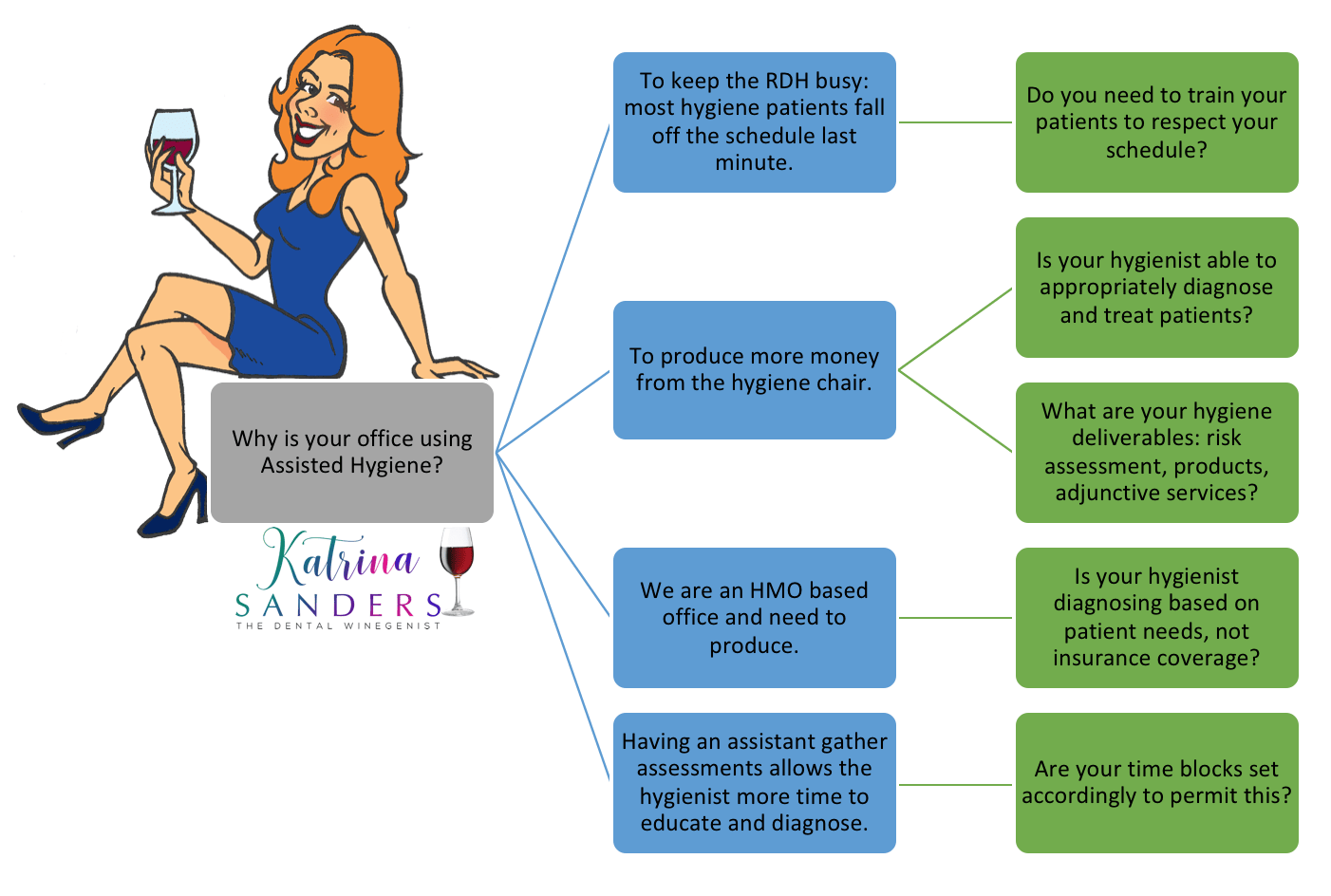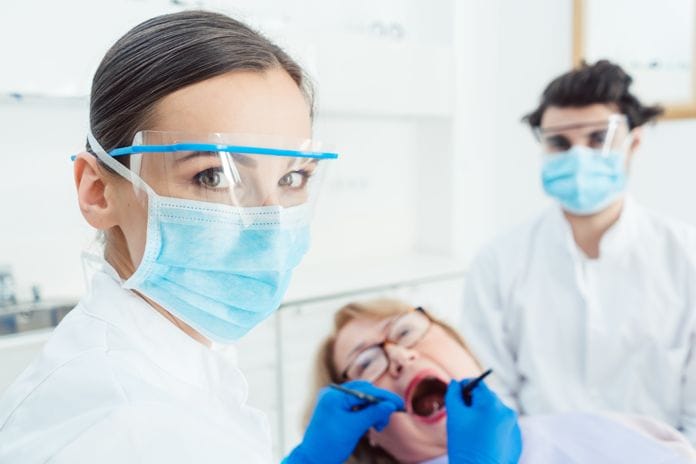I worked as a temporary hygienist at an office the other day and was approached with the strangest of concepts. I was asked if I was comfortable with assisted hygiene. My response, “Absolutely. Who is the assistant I will be working with?” Their response shocked me. I was advised I wouldn’t have an assistant working with me, but it would be fine because… insert some weird rationale about how this patient needs X-rays, but this one doesn’t, so I can just blah blah blah who cares… Honestly, I stopped listening and prayed to Darby and Wilkins that this day would just cruise by.
Here’s the deal, as a temp, it takes me 5-7 mins longer per hygiene visit (that is a made-up number, but you get the idea) than your employed RDH due to 1. Explaining: Yes, that is correct, I’m not Susan, and I’m not quite sure where she is, but I’m here so please grab a seat and let’s do this, 2. Putting on a Tony-award winning performance in an attempt to pretend I actually belong in the office by answering questions like “what kind of whitening do you do here?” and 3. Desperately searching through drawers in the op and sterile area to find the equipment and supplies I need.
So yes, front office lady whom I just met, I am comfortable with assisted hygiene. But what you’re describing, Ms. Excessively long nails and thick lip liner, is NOT assisted hygiene, but more of a do-or-die type hygiene, yes?
Here’s the rule that we, as dental hygienists, must all agree to: if you’re running two or more columns BY YOURSELF, we need to stop calling this assisted hygiene, mmmmkay! You see, as the name implies, assisted hygiene suggests there should be… oh gosh, what is that called? Oh, yeah, a dedicated assistant working with you on your columns of patients.
Now, I’m not naïve to the process of assisted hygiene. In fact, in my early hygiene years in corporate dentistry, I hand-crafted schedules in which assisted hygiene flourished. My schedule modeled a perfect day in which a trained assistant and I would cha-cha-cha between rooms, while seamlessly and eloquently greeting, diagnosing, treating, and delighting our patients. While I do not wish to brag, but I will because I can, I have proudly set an unreachable production record in multiple offices while working assisted hygiene schedules of patients who adored me, respected my assistant, and enthusiastically received the dental therapies I believed they needed. I had the time to educate my patients, I was ethically diagnosing treatment, and supporting my doctor in co-diagnosis.
The truth is, assisted hygiene can bring great production and effective care to a dental practice, but only if it is done properly. I will repeat this because I find it important: assisted hygiene can bring great production and effective care to a dental practice, but only if it is done properly. I’m humbled to be able to guide my esteemed colleagues through how to make assisted hygiene a valuable and efficient asset to their practices. This article is the first of a three-part series on the intricacies of assisted hygiene, beginning with an understanding of if your office is prepared for assisted hygiene scheduling.

The decision tree was designed for offices which are currently using or wish to integrate an assisted hygiene paradigm within their protocols. The question asks why your office is performing assisted hygiene. Responses, indicated in blue, guide the reader to additional questions, indicated in green, that must be considered in order to fine-tune their assisted hygiene protocols.
Response 1: Are you using assisted hygiene to keep the hygienist busy because the schedule falls apart on a last-minute basis? If so, I implore you to consider additional parameters with patient management. Why are patients no-showing last minute?
A natural ginger with wavy, big hair, I find it important to ensure I see my hair stylist regularly to control my giant mane. My hair stylist, Julie, only works certain days and her after-work-hours appointments, which come with a complimentary bottle, oops, I mean glass of wine, are booked out for weeks. If I want an after-work-hours bottle of wine and foils with her, I need to book this far in advance, and I would NEVER consider canceling or moving the appointment because I know it would take me weeks, or even months, before I would be able to get another appointment. I, in turn, VALUE my appointment time with her. In contrast, despite the upcoming bikini season, I know if I cannot make my 7:00 pm waxing appointment with Sandy, she likely has an open 7:30 pm appointment that same day that I can book, so it’s fine. While I (and others at the pool) appreciate the service Sandy provides, I absolutely do not and cannot value it in the same way that I do my visits with Julie.
So here is the loaded question, is your office providing opportunities for your patients to de-value your dental services? Does your front office use verbiage like, “We just had a last-minute cancellation so we can see you today,” or, “If you can’t make it today I can get you in first thing tomorrow?” Are you being so accommodating to your patients they no longer value your services?
In the same breath, I must mention, do you often have patients waiting for 15, 20, or 30 minutes beyond their scheduled appointment time? If so, I must be honest, if I were left to wait that long EVERY time I had a dental appointment, I wouldn’t think twice about showing up late, or believing my provider doesn’t respect my time at all and maybe cancelling last minute – especially if I can get a new appointment tomorrow morning. While we do call them patients, please know if your schedule is so inconsistent that excessive waiting becomes the norm, they may not be “patient” for much longer.
Response 2 and 3: Are you integrating assisted hygiene in order to increase the total hygiene production? If your office is primarily an HMO-based practice, are you feeling stuck to what insurance covers, or rather, doesn’t cover? Before considering this, the office must evaluate a few points:
- Between the hygienist, assistant, and admin time, the office is essentially paying salaries for 1.5 hygienists to see, typically, twice the number of patients in a hygiene schedule: is this fiscally responsible based on what the hygiene columns are producing?
- What is your current gingivitis protocol? If it is prophylaxis and 6-month hygiene recall, please go back to the 1950’s, hike up your poodle skirt, enjoy the “Enchantment Under The Sea” dance whilst saving the Clock Tower, then get going with the times. A solid, research-based implementation protocol which aligns with research from 2018 is a MUST, and your office needs to integrate one starting NOW.
- What is your current periodontal protocol? If it is scaling and root planing with chlorhexidine irrigation, see #2 above.
- Does the doctor consistently agree with the hygienists’ periodontal diagnosis? Nothing is more awkward or frustrating than being the hygienist who begins the perio dialogue only to have the doc come in, dismiss it, and encourage a prophy. #awkward.
- Does your office have an ideal standard of what health looks like? Is this standard agreed upon by all licensed professionals in the practice? Does your office work to achieve this level of health for all of their patients?
- Does your office encourage risk assessment evaluation? Namely, does your office integrate fluoride, xerostomia, or antimicrobial therapy based on elevated caries risk? Does your office recommend diagnostics for elevated oral cancer risk? Does your office make recommendations for patients with one or more chronic diseases, such as increased frequency of hygiene visits?
- One comment about insurance: only in dentistry do patients expect insurance to cover it all. Let me put it this way, the standard pedicure at my local nail salon is fine, but for $15 more, I get a sea salt scrub and an adorable design on my toes. This is an expense I pay beyond what I planned for because I want it. Why is it okay for “Sally” (if that’s her real name) at the nail salon to effortlessly upcharge me for some scented sea crap and a rhinestone on my big toe, but trained and licensed dental professionals get uncomfortable offering a fluoride varnish on a rampantly decayed patient? I pay an extra, like $3, for guacamole every time I order my Chipotle bowl (which may or may not be every week or something… don’t judge), but we get nervous to offer an oral cancer screening to a tobacco user.
People spend money on extended warranties, extra pump/double foam on their lattes, they super-size their meals, get the extra-large popcorn at the movies, order that extra glass of wine at dinner, upgrade the data plans on their phones, and yes, we do want fries with that. We have been culturally trained to acknowledge and accept the upgrades, upcharges, and extras in our life. So why does dentistry struggle with this? Guys, seriously, what is that?! Do you think that maybe patients don’t value the adjunctive services we recommend because… um… we kind of don’t speak confidently about them? Get with the program! Chin up, eyes forward, have confidence in the research; we ARE significant and what we have to offer can dramatically improve the quality of life for our patients, so stop acting otherwise.
Response 4: Are you fortunate enough to work for a doctor who just wants to hire you an assistant to take your radiographs, wipe down your op, and help you record probe depths so you can spend more time focusing on diagnosing and educating? If so, then GOOD FOR YOU! Your biggest challenge will be ensuring that your assistant is intuitive enough to work by your side and having the correct scheduled time blocks to promise patients will not be kept waiting.
In truth, assisted hygiene is a very unique concept that is customized based on the needs, visions, and mission statement of each individual practice. I do not believe that assisted hygiene is a one-size-fits-all, cookie-cutter scenario, and because of its flexibility in adapting to the needs of the practice, it is imperative the office continually evaluate what does and does not work with regards to how the assisted hygiene protocol meets or detracts from office goals, both production and professional in nature.
Please stay tuned for Part 2 of this three-part series on assisted hygiene scheduling, as it addresses patient needs within an assisted hygiene schedule. Cheers!
For more information on how to integrate, fine-tune, or streamline an assisted hygiene protocol in your office, contact Katrina Sanders, the Dental WINEgenist, at katrina@katrinasanders.com.
SEE ALSO: Dear IA Nerve Block: It’s Not Me, It’s YOU!
DON’T MISS: How Do I Do this All in 60 Minutes?!












